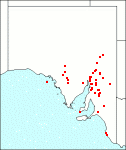Family: Rubiaceae
Galium spurium
Citation:
L., Sp. Pl. 106 (1753) subsp. ibicinum (Boiss. & Hausskn. ex Boiss.)Ehrend., Pl. Syst. Evol. 127:305 (1977).
Synonymy: G. tenerum Schleicher, Cat. Plant. Helv. edn 4:18 (1821); G. ibicinum Boiss. & Hausskn. ex Boiss., Fl. Orient. 3:70 (1875).
, Galium spurium Common name: None
Description:
Annual with weak stems up to 30 cm long, usually scrambling; stems quadrangular, with stout recurred hairs along the ridges; leaves and stipules equal, in whorls of 5 or 6, oblanceolate, rarely obovate when young, 7-16 mm long, cuspidate, with a colourless terminal seta often wearing off soon, with hooked bristles on the upper surface but especially along the slightly recurved margin, spreading.
Inflorescences axillary, 1 or 2 per node each with usually 1 flower, with filiform peduncles as long as or longer than the leaves; corolla yellowish-green.
Fruit 2-2.5 mm long, with 2 broadly reniform to hemispherical mericarps loosely attached to one another, each more or less densely covered with hooked hairs; fruiting stalks spreading.
|
|
Distribution:
|
S.Aust.: GT, FR, EA, EP, NL, MU, YP, SL, SE. N.S.W.; Vic.; Tas. Native and widespread in Europe.
|
Conservation status:
naturalised
Flowering time: Sept. — Nov.
|

SA Distribution Map based
on current data relating to
specimens held in the
State Herbarium of South Australia
|
Biology:
No text
Taxonomic notes:
G. spurium is mainly distinguished from G. aparine by its smaller fruit and the absence of long spreading hairs on the nodes. Vegetative material is superficially similar to G. migrans although G. spurium has usually 5 or 6 'leaves' per whorl.
Author:
Not yet available
|

